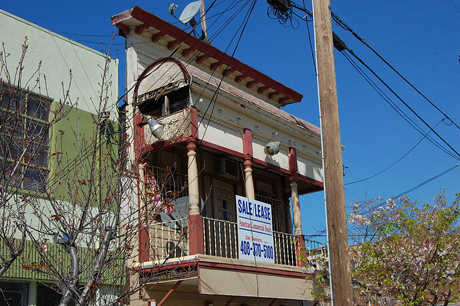A nearly 100-year-old Chinese restaurant may get a historic designation, protecting it from new development. The City Council on Tuesday will vote whether to make Ken Ying Low an official historic landmark. Located at 625 N. Sixth St. in Japantown, the building is the last vestige of what was once a Chinese neighborhood.
San Jose was once a gateway to the southern mines for Chinese immigrants in the mid-19th Century, a supply stop on the way to the port of Alviso, according to the National Park Service. Gradually, a Chinese-American community settled around Market and San Fernando streets near downtown. As the neighborhood expanded, city leaders talked about the “abatement” of Chinatown and finding a way to move Chinese-Americans to the outskirts of town.
In 1887, a fire flared up in three parts of town, destroying the mostly wood structures. Apparently by design, the 10,000-gallon water tank in Chinatown was nearly empty that day. Residents lost all their belongings and weren’t allowed to build in the same spot because of recent laws passed that prevented Chinese from owning land in California.
But the property at Sixth and Taylor, the site of Ken Ying Low, was leased for $1,500 a month from German immigrant John Heinlen through a Chinese company. Ken Ying Low was constructed in 1887, originally as a Japanese boarding house within Chinatown, which then was known as Heinlenville, after the German landowner. By 1915, the building came under Chinese ownership and the restaurant established.
Development razed all of Chinatown in the 1930s, including an ornate temple. Ken Ying Low is the only original building left standing.
“The commercial property dates to an early period in Japantown’s history, when Japanese immigrants brought to Santa Clara County by agricultural work were establishing a permanent community in San Jose and when Heinlenville still existed nearby,” writes Leslye Corsiglia, the city’s director of housing. “It illustrates the interconnectedness of these two minority groups, which settled in close proximity to each other for security and tolerance. “
The Historic Landmarks Commission in September unanimously supported the historic landmark designation, which allows lower property taxes and gives landlords more cash for upkeep.
More from the San Jose City Council agenda for October 1, 2013:
• The city will likely pay $102,000 to get out of another federal lawsuit filed against it by a man who accuses police of fracturing his arm and dislocating his shoulder while cuffing him seven years ago. On Aug. 26, 2006, Jermaine Monteil brought an injured man to the hospital, but he refused treatment and caused a disturbance. Police arrested the injured man and Monteil, who says he sustained injuries after the arrest. Of the settlement, $77,000 will pay Monteil’s attorney fees and the rest to Monteil.
• Looks like Lyncon Construction is about to win a bid to build the city a new Traffic Incident Management Center, which manages traffic signal operations. Cash for the $2.4 million bid comes from a $5.4 million federal grant.
• City staff recommends support for proposed legislation that would make it tougher for copper thieves to make a profit from recycling stolen metal.
• Counting trees in Cambrian, Almaden and South San Jose will cost the city $154,000, if a contract is awarded to The Davey Tree Expert Company.
• Seventy-five percent of the food and drinks in city-owned vending machines will have to be healthy (low sugar, low fat), if a motion passes. The current required rate of healthy options is 50 percent.
WHAT: City Council meets
WHEN: 1:30pm Tuesday
WHERE: City Hall, 200 E. Santa Clara St., San Jose
INFO: 408.535.1260


The $154,126 being requested will pay for tree counting in “Area C”. The amounts for Areas A, B, D and E are $58,666, $113,763, $60,810 and $83,194 respectively. The total comes to $470,559.
The justification for these expenditures is:
This Council item is consistent with Council approved Budget Strategy General Principal #2: “We must
focus or protecting our vital core City Services.”
Counting trees is vital to our core City Services? Excuse me, but I think we should concentrate on *real* city services. Deregulate tress, and leave decisions on their maintenance up to property owners.
Who at the City is actually going to do anything useful with the mountain of data that’ll be generated from this tree count? Nobody. They’ll look at it once and be overwhelmed.
Isn’t there a city arborist drawing a nice big salary? And isn’t his name Ralph Mise? Can’t Ralph Mise go out and about and make informed decisions on trimming street trees? What are we paying him for anyway?
I’d love to see the City take care of it’s portion of the urban forest. But as usual they blow through the budget doing studies. By the time they finish paying for this tree inventory there won’t be any money left to actually DO anything.
> The total comes to $470,559.
I doubt if San Jose has 470,559 trees, so this probably amounts to more than a buck per tree counted.
I wonder if there is a way I could count trees on the way to Starbucks and pick up a little extra cash from the city.
This sounds like the kernel of another idea for the Democrats to create “jobs, jobs, jobs”.
Probably more like an arborist survey, describing the health of each individual tree.
Wings was established in 1925. That is certainly historical; there are a few other buildings in Jtown that date back that far, including the Nishioka Fish Market building.